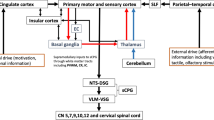Summary
The case of a 75-year-old man with Guillain-Barré syndrome is presented. By means of transcranial electrical stimulation and epidural recording at the spinal level L2-3, distinct potentials with a latency of 21ms were obtained when the patient was tetraplegic. At the same time electromyographic responses of the thenar and anterior tibial muscles were absent following both transcranial and peripheral nerve stimulation. The patient recovered partially within 4 weeks. It is concluded that epidurally recorded motor evoked responses allow electrophysiological assessment of the descending pathways even in severe cases of Guillain-Barré syndrome and might contribute to a more accurate prediction of outcome.
Similar content being viewed by others
References
Barker AT, Jalinous R, Freeston IL (1985) Non-invasive magnetic stimulation of human motor cortex. Lancet 1:1106–1107
Boyd SG, Rothwell JC, Cowan JMA, Webb PJ, Morley T (1986) A method of monitoring functions in corticospinal pathways during scoliosis surgery with a note on motor conduction velocities. J Neurol Neurosurg Psychiatry 49:251–257
Brown WF, Feasby TE (1984) Conduction block and denervation in Guillain-Barré polyneuropathy. Brain 107:219–239
Cowan JMA, Dick JPR, Day BL, Rothwell JC, Thompson PD, Marsden CD (1984) Abnormalities in central motor pathway conduction in multiple sclerosis. Lancet II:304–307
Levy WJ (1987) Clinical experience with motor and cerebellar evoked potential monitoring. Neurosurgery 20:169–182
Levy WJ, McCaffrey M, York DH, Tanzer F (1984) Motor evoked potentials from transcranial stimulation of the motor cortex in humans. Neurosurgery 15:214–227
Merton PA, Morton HB (1980) Stimulation of the cerebral cortex in the intact human subject. Nature 285:227
Mills KR, Murray NMF (1985a) Proximal conduction block in early Guillain-Barré syndrome. Lancet I:659
Mills KR, Murray NMF (1985b) Corticospinal tract conduction time in multiple sclerosis. Ann Neurol 18:601–605
Rossini PM, Caramia MD, Zarola F (1987) Mechanisms of nervous propagation along central motor pathways: noninvasive evaluation in healthy subjects and in patients with neurological disease. Neurosurgery 20:183–191
Snooks SJ, Swash M (1985) Motor conduction velocity in the human spinal cord: slowed conduction in multiple sclerosis and radiation myelopathy. J Neurol Neurosurg Psychiatry 48:1135–1139
Author information
Authors and Affiliations
Rights and permissions
About this article
Cite this article
Zentner, J., Ebner, A. Motor evoked responses recorded epidurally in a patient with Guillain-Barré syndrome. Eur Arch Psychiatr Neurol Sci 238, 31–32 (1988). https://doi.org/10.1007/BF00381077
Received:
Issue Date:
DOI: https://doi.org/10.1007/BF00381077




